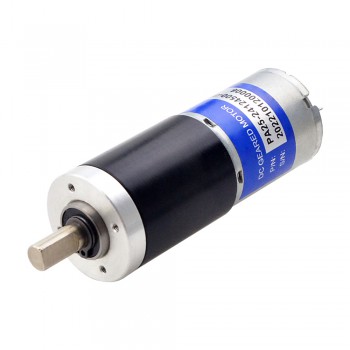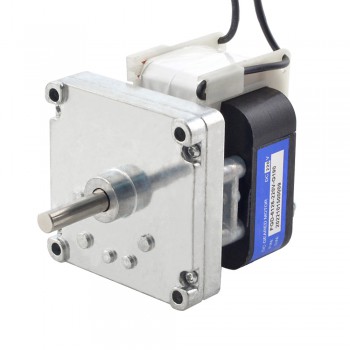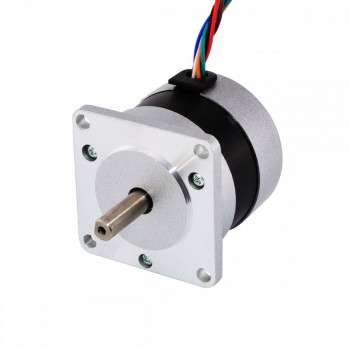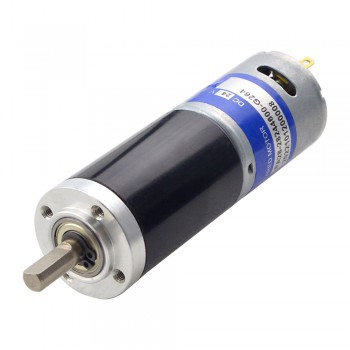dc
How to distinguish different types of motors
Автор: gushsd23 gushsd23 04.09.2023
The difference between DC and AC motors:
As the name suggests, small DC motors use direct current as the power source, while AC motors use alternating current as the power source. Structurally speaking, the principle of DC motors is relatively simple, but the structure is complex and not easy to maintain. The principle of AC motors is complex, but their structure is relatively simple, and they are easier to maintain than DC motors.

In terms of price, DC motors with the same power are higher than AC motors. Including speed control devices, the price of DC is higher than that of AC, but there are also significant differences in structure and maintenance. In terms of performance, due to the stable speed and precise speed control of DC motors, which cannot be achieved by AC motors, DC motors have to be used to replace AC motors under strict speed requirements. AC motor speed regulation is relatively complex, but it is widely used due to the use of AC power sources in chemical plants.

The difference between synchronous and asynchronous motors:
The rotation speed of the rotor is the same as that of the stator, which is called a synchronous motor. If not consistent, it is called an asynchronous motor.
The difference between ordinary and variable frequency drive motors:
Firstly, it should be clarified that ordinary motors cannot be used as variable frequency motors. Ordinary motors are designed based on constant frequency and voltage, and cannot fully meet the requirements of variable frequency speed regulation, therefore they cannot be used as variable frequency motors.
The frequency converter can generate varying degrees of harmonic voltage and current during operation, causing the motor to operate under non sinusoidal voltage and current. High order harmonics inside can cause an increase in stator copper loss, rotor copper loss, iron loss, and additional losses of the motor. The most significant one is the rotor copper loss, which will cause additional heating, reduce efficiency, and output power of the motor. The temperature rise of ordinary motors generally increases by 10-20%. The carrier frequency of the frequency converter ranges from several thousand hertz to more than ten thousand hertz, causing the stator winding of the motor to withstand a high voltage rise rate, which is equivalent to applying a steep impulse voltage to the motor, causing the insulation between turns of the motor to withstand a more severe test.
When ordinary motors are powered by frequency converters, the vibration and noise caused by electromagnetic, mechanical, ventilation and other factors become more complex. The various harmonics contained in the variable frequency power supply interfere with the inherent spatial harmonics of the electromagnetic part of the motor, forming various electromagnetic excitation forces and increasing noise.
Buy Small DC Motor 12V / 24V / 36V for Sale online at Oyostepper.com
The definition and characteristics of DC stepper motors
Автор: gushsd23 gushsd23 29.08.2023A DC stepper motor is a type of motor that can convert electrical signals into mechanical motion. It controls the movement of the rotor by continuously switching on and off current. A DC stepper motor realizes the movement of the rotor by changing the position and size of the electrode magnetic field. It mainly consists of the stator, rotor, magnetic field device, and other parts. When the current flows through the stator coil, a magnetic field is formed around it, and the rotor is adsorbed in this magnetic field. At this time, as long as the direction and intensity of the current are changed, the magnetic field will change accordingly, and the rotor will also rotate accordingly, thus achieving step motion.

Characteristics of DC stepper motors:
DC stepper motors have many advantages, including the following:
1. High torque accuracy: Small DC motor has high control accuracy and stable and reliable output torque.
2. Strong environmental adaptability: Small DC motors have excellent performance in dust, water, and shock resistance, and are suitable for use in various environmental conditions.
3. Small size and light weight: Small DC motor is compact in all parts, small in size and light in weight, and easy to carry and use.
4. High self-locking performance: The stepper motor can achieve self-locking based on changes in control signals, resulting in low standby power consumption and high efficiency.
5. Simple control: The control of stepper motors can be achieved through microprocessors or control chips, with simple circuit design and low cost.

DC motors are widely used in computer peripheral devices (such as magnetic disks and optical disk storage), household appliances, medical devices, and electric vehicles. The rotor of brushless DC motors generally uses magnetic steel composed of permanent magnet materials, which is widely used in industries such as aviation, aerospace, automotive, and precision electronics. In electrical equipment, in addition to DC electromagnets (DC relays, DC contactors, etc.), the most important application is in DC rotating motors.
In power plants, the exciter of synchronous generators and the charger of batteries are DC generators; The prime mover of the boiler powder feeder is a DC motor. In addition, in many industrial applications, such as large steel rolling equipment, large precision machine tools, mine winches, urban trams, cable equipment, and other places that strictly require consistent linear speed, DC motors are usually used as prime movers to drive working machinery. A DC generator is usually used as a DC power source to output electrical energy to the load; DC motors serve as prime movers to drive various production machinery and output mechanical energy to the load. In control systems, DC motors have other uses, such as speed measuring motors, servo motors, etc., which utilize the interaction between electricity and magnetism to convert mechanical energy.
The definition and characteristics of DC stepper motors
Автор: gushsd23 gushsd23 29.08.2023A DC stepper motor is a type of motor that can convert electrical signals into mechanical motion. It controls the movement of the rotor by continuously switching on and off current. A DC stepper motor realizes the movement of the rotor by changing the position and size of the electrode magnetic field. It mainly consists of the stator, rotor, magnetic field device, and other parts. When the current flows through the stator coil, a magnetic field is formed around it, and the rotor is adsorbed in this magnetic field. At this time, as long as the direction and intensity of the current are changed, the magnetic field will change accordingly, and the rotor will also rotate accordingly, thus achieving step motion.

The characteristics of DC stepper motors:
1. High torque accuracy: Small DC motor has high control accuracy and stable and reliable output torque.
2. Strong environmental adaptability: Stepper motors have excellent performance in dust, water, and shock resistance, and are suitable for use in various environmental conditions.
3. Small size and light weight: Small DC motor is compact in all parts, small in size and light in weight, and easy to carry and use.
4. High self-locking performance: Small DC motor can achieve self-locking based on changes in control signals, resulting in low standby power consumption and high efficiency.
5. Simple control: The control of stepper motors can be achieved through microprocessors or control chips, with simple circuit design and low cost.

DC motors are widely used in computer peripheral devices (such as magnetic disks and optical disk storage), household appliances, medical devices, and electric vehicles. The rotor of brushless DC motor generally uses magnetic steel composed of permanent magnet materials, which is widely used in industries such as aviation, aerospace, automotive, and precision electronics. In electrical equipment, in addition to DC electromagnets (DC relays, DC contactors, etc.), the most important application is in DC rotating motors.
In power plants, the exciter of synchronous generators and the charger of batteries are DC generators. The prime mover of the boiler powder feeder is a DC motor. In addition, in many industrial applications, such as large steel rolling equipment, large precision machine tools, mine winches, urban trams, cable equipment, and other places that strictly require consistent linear speed, DC motors are usually used as prime movers to drive working machinery. A DC generator is usually used as a DC power source to output electrical energy to the load. DC motors serve as prime movers to drive various production machinery and output mechanical energy to the load. In control systems, DC motors have other uses, such as speed measuring motors, servo motors, which utilize the interaction between electricity and magnetism to convert mechanical energy.
The definition and characteristics of DC stepper motors
Автор: gushsd23 gushsd23 29.08.2023A DC stepper motor is a type of motor that can convert electrical signals into mechanical motion. It controls the movement of the rotor by continuously switching on and off current. A DC stepper motor realizes the movement of the rotor by changing the position and size of the electrode magnetic field. It mainly consists of the stator, rotor, magnetic field device, and other parts. When the current flows through the stator coil, a magnetic field is formed around it, and the rotor is adsorbed in this magnetic field. At this time, as long as the direction and intensity of the current are changed, the magnetic field will change accordingly, and the rotor will also rotate accordingly, thus achieving step motion.

The characteristics of DC stepper motors:
1. High torque accuracy: Small DC motor has high control accuracy and stable and reliable output torque.
2. Strong environmental adaptability: Stepper motors have excellent performance in dust, water, and shock resistance, and are suitable for use in various environmental conditions.
3. Small size and light weight: Small DC motor is compact in all parts, small in size and light in weight, and easy to carry and use.
4. High self-locking performance: Small DC motor can achieve self-locking based on changes in control signals, resulting in low standby power consumption and high efficiency.
5. Simple control: The control of stepper motors can be achieved through microprocessors or control chips, with simple circuit design and low cost.

DC motors are widely used in computer peripheral devices (such as magnetic disks and optical disk storage), household appliances, medical devices, and electric vehicles. The rotor of brushless DC motor generally uses magnetic steel composed of permanent magnet materials, which is widely used in industries such as aviation, aerospace, automotive, and precision electronics. In electrical equipment, in addition to DC electromagnets (DC relays, DC contactors, etc.), the most important application is in DC rotating motors.
In power plants, the exciter of synchronous generators and the charger of batteries are DC generators. The prime mover of the boiler powder feeder is a DC motor. In addition, in many industrial applications, such as large steel rolling equipment, large precision machine tools, mine winches, urban trams, cable equipment, and other places that strictly require consistent linear speed, DC motors are usually used as prime movers to drive working machinery. A DC generator is usually used as a DC power source to output electrical energy to the load. DC motors serve as prime movers to drive various production machinery and output mechanical energy to the load. In control systems, DC motors have other uses, such as speed measuring motors, servo motors, which utilize the interaction between electricity and magnetism to convert mechanical energy.
The definition and characteristics of DC stepper motors
Автор: gushsd23 gushsd23 29.08.2023A DC stepper motor is a type of motor that can convert electrical signals into mechanical motion. It controls the movement of the rotor by continuously switching on and off current. A DC stepper motor realizes the movement of the rotor by changing the position and size of the electrode magnetic field. It mainly consists of the stator, rotor, magnetic field device, and other parts. When the current flows through the stator coil, a magnetic field is formed around it, and the rotor is adsorbed in this magnetic field. At this time, as long as the direction and intensity of the current are changed, the magnetic field will change accordingly, and the rotor will also rotate accordingly, thus achieving step motion.

The characteristics of DC stepper motors:
1. High torque accuracy: Small DC motor has high control accuracy and stable and reliable output torque.
2. Strong environmental adaptability: Stepper motors have excellent performance in dust, water, and shock resistance, and are suitable for use in various environmental conditions.
3. Small size and light weight: Small DC motor is compact in all parts, small in size and light in weight, and easy to carry and use.
4. High self-locking performance: Small DC motor can achieve self-locking based on changes in control signals, resulting in low standby power consumption and high efficiency.
5. Simple control: The control of stepper motors can be achieved through microprocessors or control chips, with simple circuit design and low cost.

DC motors are widely used in computer peripheral devices (such as magnetic disks and optical disk storage), household appliances, medical devices, and electric vehicles. The rotor of brushless DC motor generally uses magnetic steel composed of permanent magnet materials, which is widely used in industries such as aviation, aerospace, automotive, and precision electronics. In electrical equipment, in addition to DC electromagnets (DC relays, DC contactors, etc.), the most important application is in DC rotating motors.
In power plants, the exciter of synchronous generators and the charger of batteries are DC generators. The prime mover of the boiler powder feeder is a DC motor. In addition, in many industrial applications, such as large steel rolling equipment, large precision machine tools, mine winches, urban trams, cable equipment, and other places that strictly require consistent linear speed, DC motors are usually used as prime movers to drive working machinery. A DC generator is usually used as a DC power source to output electrical energy to the load. DC motors serve as prime movers to drive various production machinery and output mechanical energy to the load. In control systems, DC motors have other uses, such as speed measuring motors, servo motors, which utilize the interaction between electricity and magnetism to convert mechanical energy.

